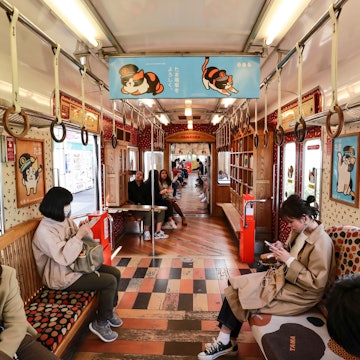

Cycling is one of the many wonderful ways to explore Kyoto © Satoshi-K / Getty Images
Kyoto is a relatively compact city with a great public transport network, making traveling around a breeze. Its easily navigable streets and mostly flat ground also mean it's an enjoyable destination to explore by bike or on foot.
We've got all the insider tips and tricks you need to easily get around in Kyoto.
Get around major sights quickly on the subway
Kyoto has two subway lines: the Karasuma Line, which runs from the north of the city to the south, and the Tozai Line, which runs from east to west. They intersect in the city center at Karasuma Oike Station, where you can transfer between them. Both also connect with other railway lines at various stations, creating a comprehensive network.
Despite having only two lines, the subway is a convenient option for traveling to many key spots in downtown Kyoto and the Higashiyama sightseeing district. It’s quick and comfortable, easier to navigate than buses and cheaper than taking a taxi. Unlimited day passes are available, which also get you discounts at several tourist spots, including Nijō-jō castle and the Kyoto International Manga Museum. For more coverage, you can buy one- and two-day passes that give you unlimited travel on both the subway and the city buses.

Explore beyond the center on a train
Japan is famous for its excellent rail systems, and Kyoto is no exception. Several train lines operate within the city, including national JR lines and local private ones. You can expect services to be comfortable and clean and depart precisely on time. The train is often the best way to reach parts of Kyoto that are slightly farther out, such as Arashiyama, Tōfuku-ji temple and Fushimi Inari-Taisha shrine. It’s also the most convenient way to travel to nearby cities like Osaka and Nara.
HyperDia is one of the best English-language sites for planning your journey, and you can buy tickets from booths in the station or one of the many automatic ticket machines. Don’t worry if you make a mistake, as most stations also have fare adjustment machines by the exit barriers, where you can pay any extra charge and get a new ticket.
The bus covers parts of the city that trains don't reach
Many of Kyoto’s most popular attractions – including Kinkaku-ji and Ginkaku-ji temples – are not located near train or subway stations, and the bus is the ideal option to bridge the gap. Kyoto has a wealth of bus routes operated by a few different companies, and most make announcements in both English and Japanese. Buses can get very crowded at times, especially during the spring cherry blossom and fall foliage seasons. The quicker option is often to walk or cycle.
On most buses, you board at the back and exit at the front. To pay your fare, put the exact change in coins into the box next to the driver as you get off (there’s another machine next to it that breaks down coins and ¥1,000 bills). Within the city center, it’s a flat fare of ¥230 per journey, and on longer routes, you take a numbered ticket when you get on and use that to check your fare on the screen at the front when you exit. Unlimited day passes are available for use within the flat fare zone.
Get an Icoca card for cash-free payments
Kyoto has a prepaid IC card called Icoca, which you can use on the subway and virtually all the city’s trains and buses (as well as those in several other cities). These don’t offer travel discounts but are much more convenient than queuing up to buy paper tickets or finding change for the bus (if you’re coming from Tokyo, you can use the Pasmo IC card in Kyoto, too). If you have a JR Pass, you can use it for unlimited travel on the JR train lines in Kyoto, but it’s unlikely to save you money if you only use it within the city.
See the city on two wheels
Cycling is one of the best ways to get around Kyoto. The city is mostly flat and easy to navigate, with well-maintained roads and plenty of shops where you can rent bikes. The challenging part is finding somewhere to park your bike, as you must use designated parking areas – if not, you may find your ride gets impounded.
Most temples, museums and other tourist spots have small parking areas for bikes, and there are also some city-operated ones in busy locations. When riding, cycle on the left-hand side of the road or use a shared sidewalk with pedestrians. Helmets are only a legal requirement for children under 12, but you must use a light if cycling at night.

Walking around Kyoto is a pleasure
Kyoto is an extremely walkable city thanks to its compact size, flat ground, high levels of road safety and logical layout. Exploring on foot gives you the chance to discover more of the city's atmospheric streets and scenic pathways. Some of the most pleasant walking routes include the Path of Philosophy, which runs along a canal between Ginkaku-ji and Eikan-dō temples, and the footpath beside the Kamogawa River. Higashiyama and Arashiyama have walking routes that link up many of their famous sightseeing spots, though these get busy during the peak cherry blossom and fall foliage seasons.
A taxi is a cheap option for groups
Taxis are commonplace in Kyoto, and it’s easy to flag one down on the street or hop in at a taxi rank. Drivers will open and close the rear door for you automatically. Fares are displayed on a meter inside, and although an expensive option for solo travelers, it can be cheaper than getting the bus if you’re in a group.
Many drivers speak limited English, so it’s helpful to have your destination written down in Japanese to show them (hotels often give you a business card for this reason). Alternatively, if you’re at Kyoto Station or using the Japan Taxi app, you can take a clearly marked “foreigner-friendly” taxi at no extra cost.
A car is a hindrance in the city
Renting a car is not necessary to get around Kyoto city, and it’s often actually more inconvenient. However, a car can be useful if you’re planning to visit some of the more remote parts of the wider prefecture. Those who choose to drive will need an international driving license. Driving in Japan is generally safe, although navigation can be tricky if you can’t read Japanese.

Accessible transportation in Kyoto
Accessibility in Kyoto has improved greatly in recent years, particularly in the city center. Most large train and subway stations have wider ticket gates and elevators to access the platforms, and the majority of train lines have priority seats and carriages with spots for wheelchairs.
You can always ask the station staff if you require assistance. Raised blocks on station floors and platforms assist passengers with visual impairments. The majority of buses that run in the city center are now accessible. The driver will set up a ramp for wheelchair users to get on and also help you off at your destination.
Click here to download Lonely Planet's free accessible travel resources.
















